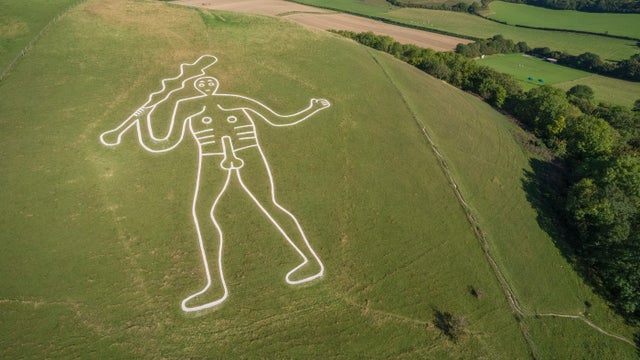MAY 5, 2023
By Harry Mottram: A day ahead of a Coronation party on the lawns in front of the Royal Crescent in Bath a giant phallus has been neatly trimmed into the grass symmetrically in line with the Georgian terrace. National newspapers have quickly published a birds eye view of the masculine symbol often seen scrawled on walls and the interiors of public toilets and dare we say by naughty school boys or men who haven’t yet grown up. Society generally sees the symbol either as an obscene piece of graffiti or a slightly comical if saucy drawing.
The photo by the National Trust shows the hill figure known as the well endowed Cerne Abbas in Dorset, England – and is one of the better known examples of the male member on display to passing motorists. Archaeologists have argued about its origins with theories ranging from a Neolithic border marker to an early medieval symbol later than AD700 or even as late as the 12th Century.
Ever since people began to create carvings it seems the phallus has been part of the lexicon of craftsmen and women engaged in creating male images. In Greece over large carvings of the male penis appear in classical times as representations of Pan the son of the God Hermes. The Classical Greek God of fertility Priapus was often depicted with an exaggerated phallus and was seen a good luck symbol for those hoping for a good harvest or a large family and as a protector of farm animals, fruit trees and er… a chap’s manhood. The Greeks don’t have the same hang ups as us Brits about such things shall we say as the city of Tyrnavos in the Mediterranean country features an annual fertility festival featuring the phallus in all its glories. Tourists will be familiar with the cheeky symbol sold as fridge magnets, pendants and mini statues passed off as symbols from Classical Greece.

The Romans used the phallus symbol as a lucky charm and it was carved into walls, found as pendants and as an amulet often worn by boys and is widely seen in Ancient Roman culture related to fertility also to ward off evil spirits. In short a kind of lucky charm that was a world away from being seen as an obscene symbol.
Back to the phallus on the lawns of the Royal Crescent. The Council are in charge of trimming the grass where the phallus was cut (which can only really be seen from the air) while the Crescent Lawn Company run a lawn mower over the top section.
Although not on the scale of the intricate crop circles clearly the pranksters or vandals (take your pick) wanted to make a point. Whether it was as a fertility symbol or as making some sort of point about the Coronation we will leave to conjecture – whatever – it won’t hold up the picnic planned to celebrate the Coronation this weekend.
Bath Voice Monthly Newspaper is distributed free to thousands of homes and some supermarkets – distributed from the first of the month. Harry Mottram is the News Editor
Email him at news@bathvoice.co.uk
Bath website: https://bathvoice.co.uk/news/
Bath Facebook: https://tinyurl.com/bdtf2kep
Also on Twitter: https://twitter.com/bath_voice
Read the newspaper online at :https://issuu.com/bathvoice
To advertise to thousands of Bathonians call Erica on 07402 441485 or email her on erica@bathvoice.co.uk
Harry Mottram is a freelance journalist. Follow him on Facebook, LinkedIn, Twitter, Instagram, YouTube etc
Email:harryfmottram@gmail.com
Website:www.harrymottram.co.uk
Mobile: 07789 864769


You must be logged in to post a comment.